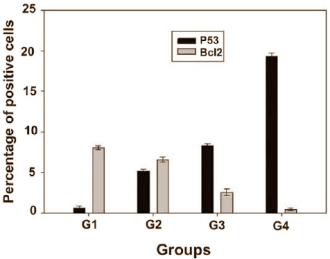|
Definition: "An ergogenic aid is any substance or phenomenon that enhances performance "
|
|
||||||||
10.09.2011 |
|
|
Boldenone may damage liver, says animal study
According to the handbooks, boldenone is not dangerous for the liver. After all boldenone doesn't have a 17 alpha-methyl group, and non-17alpha-methylated steroids don't affect your liver. That's what the handbooks say, but according to an Egyptian animal study, boldenone undecylenate may be an exception to the rule.
The Egyptians used rabbits for their experiment. They injected the animals in the control group with olive oil [G1], and gave the rabbits in the experimental groups injections containing 5 mg boldenone undecylenate per kg bodyweight. The G2 group was given a single injection; the G3 group got two and the G4 group three injections. Between each injection was a period of three weeks.
At the end of the course of boldenone, the rabbits were dissected and the Egyptians studied the animals' liver. When they examined samples under the microscope they saw that, despite the fact that there was no 17-alpha-methyl group, the anabolic steroid had caused liver damage. The researchers saw fatty liver cells and non-functioning connective tissue.
Because they wanted to measure more objectively what had happened in the liver – and probably because good pathologists are a dying breed in Egypt – the researchers measured the concentration of the suicide protein p53 and the anti-suicide protein Bcl-2 in the liver cells. If liver cells are put under too much stress, the production of p53 increases and that of Bcl-2 declines. And that's exactly what happened in the G2, G3 and G4 groups.
"There is significant increase in the histopathological changes and the incidence of the apoptosis after boldenone injection", the Egyptians conclude. "So, people should be careful if they want to use such steroids to enhance their strength and endurance."
Doctors do sometimes encounter chemical bodybuilders with liver damage as a result of taking boldenone, according to Ergo-Log's sources. But the problems are not usually of a lasting nature.
In the 1960s and 70s researchers tested boldenone undecylenate several times on humans. Its name in those days was Parenabol or 29'038-Ba. In a 1968 study, fortnightly injections with 50 mg boldenone undecylenate had no adverse effects on the liver. [European Journal of Clinical Pharmacology Volume 1, Number 2 / October, 1968.] Nevertheless, pharmaceuticals companies decided it would be better to confine boldenone use to preparations for animals. Research on humans stopped after this, so we now know very little about the effects of boldenone undecylenate on humans.
Source:
More:
|
|


